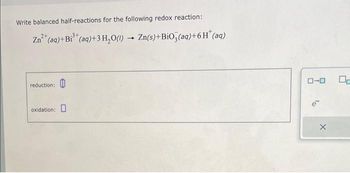
Chemistry
10th Edition
ISBN: 9781305957404
Author: Steven S. Zumdahl, Susan A. Zumdahl, Donald J. DeCoste
Publisher: Cengage Learning
expand_more
expand_more
format_list_bulleted
Concept explainers
Question
Please type answer note write by hend

Transcribed Image Text:Write balanced half-reactions for the following redox reaction:
Zn²+ (aq) +Bi³+ (aq) + 3 H₂O()
reduction:
oxidation:
-
Zn(s)+BiO3(aq) + 6H* (aq)
ローロ
X
Expert Solution
This question has been solved!
Explore an expertly crafted, step-by-step solution for a thorough understanding of key concepts.
Step by stepSolved in 5 steps

Knowledge Booster
Learn more about
Need a deep-dive on the concept behind this application? Look no further. Learn more about this topic, chemistry and related others by exploring similar questions and additional content below.Similar questions
- Ald Summary Account Dash O Lyrical: Yeh Is x www-awn.aleks.com/alekscgi/x/lsl.exe/1o_u-lgNslkr7j8P3jH-lijkPWvZoZLqkt1FLlq7wcPWKzBYGfE9IMFjNv26NxcUIFt8F81Y80MQxnZhc7Hg9N2Qzofv.. O MATTER Calculating volume by combining the volume of simple shapes A chemistry student in lab needs to fill a temperature-control tank with water. The tank measures 27.0 cm long by 21.0 cm wide by 10.0 cm deep. In addition, as shown in the sketch below, the student needs to allow 2.0 cm between the top of the tank and the top of the water, and a round-bottom flask with a diameter of 7.5 cm will be just barely submerged in the water. Calculate the volume of water in liters which the student needs. Round your answer to the nearest 0.1 L. 2 cm flask water Explanation Check © 2021 McGraw-Hill Education. AlI Riahts Reserved. Terms of Use | Privacy | Acc の @ 6 étv MacBook Airarrow_forwardHelp 100% 47 T. "ublic Health Ch HSC 258 - Major Projec x MindTap - Cengage Lea X C The Illustration To T =55750828934189288909969212&elSBN=9781305657571&id=D1061392007&nbld=21... * Q Search t Referonces Use the References to access important values if needed for this question. For the following reaction, 50.4 grams of sulfur dioxide are allowed to react with 17.9 grams of water. sulfur dioxide (g) + water (I) sulfurous acid (H2SO3) (g) grams What is the maximum amount of sulfurous acid (H,SO3) that can be formed? What is the FORMULA for the limiting reagent? grams What amount of the excess reagent remains after the reaction is complete? Submit Answerarrow_forwardne File Edit View History Bookmarks Profiles Tab Evolution of the Genome-Cell X Significant Figures Counter E esc X Mathway | Algebra Problem So x A ALEKS-Lara Althawadi - Lear X C www-awu.aleks.com/alekscgi/x/lsl.exe/1o_u-IgNslkr7j8P3jH-IvTqeviKFP6W0cqJcWJdIACROQwyw24GWHInqCmj000aolPZo5oqa7WgLOML1yaFz8E-CEGkqhv... solution Form M Gmail OKINETICS AND EQUILIBRIUM Setting up a reaction table initial change equilibrium G hess law organic c.... YouTube Maps Suppose a 250. mL flask is filled with 0.80 mol of H₂ and 0.90 mol of NH₂. This reaction becomes possible: N₂(g) + 3H₂(g)2NH, (g) Complete the table below, so that it lists the initial molarity of each compound, the change in molarity of each compound due to the reaction, and the equilibrium molarity of each compound after the reaction has come to equilibrium. Use x to stand for the unknown change in the molarity of N₂. You can leave out the M symbol for molarity. Explanation CA 17,306 N₂ 0 X 0 Check 3 Tab Window Help H₂ 0 0 9 NH, 0 0 0…arrow_forward
- 9. What might the reaction coordinate diagram look like for the following reaction? ii - Free energy Ryn progressarrow_forwardRb Blackboard Collaborate Ultra -2 x General Psychology -Fall 20 How to Find a Career Path Using X V What Kind of Intelligence Do You X A ALEKS - Griffin Barden- Learn com/alekscgi/x/Isl.exe/1o_u-IgNslkr7j8P3jH-IJcZzdcvSCzsqTCIDqNGV3bKqhMfPmUcQ4ENkmiXn9QCwgeDPDkQ06yszYWESPcekwL0-Qg6l19rekU7404HgFAGBEZaDr080?1oBw7QYjlbavbSPXtx-YCjsh_7mMmrq O THERMOCHEMISTRY Griffin Calculating a molar heat of reaction from formation enthalpies Using the table of standard formation enthalpies that you'll find under the ALEKS Data tab, calculate the reaction enthalpy of this reaction under standard conditions: (6)°Hɔ-(5)arrow_forward
arrow_back_ios
arrow_forward_ios
Recommended textbooks for you
 ChemistryChemistryISBN:9781305957404Author:Steven S. Zumdahl, Susan A. Zumdahl, Donald J. DeCostePublisher:Cengage Learning
ChemistryChemistryISBN:9781305957404Author:Steven S. Zumdahl, Susan A. Zumdahl, Donald J. DeCostePublisher:Cengage Learning ChemistryChemistryISBN:9781259911156Author:Raymond Chang Dr., Jason Overby ProfessorPublisher:McGraw-Hill Education
ChemistryChemistryISBN:9781259911156Author:Raymond Chang Dr., Jason Overby ProfessorPublisher:McGraw-Hill Education Principles of Instrumental AnalysisChemistryISBN:9781305577213Author:Douglas A. Skoog, F. James Holler, Stanley R. CrouchPublisher:Cengage Learning
Principles of Instrumental AnalysisChemistryISBN:9781305577213Author:Douglas A. Skoog, F. James Holler, Stanley R. CrouchPublisher:Cengage Learning Organic ChemistryChemistryISBN:9780078021558Author:Janice Gorzynski Smith Dr.Publisher:McGraw-Hill Education
Organic ChemistryChemistryISBN:9780078021558Author:Janice Gorzynski Smith Dr.Publisher:McGraw-Hill Education Chemistry: Principles and ReactionsChemistryISBN:9781305079373Author:William L. Masterton, Cecile N. HurleyPublisher:Cengage Learning
Chemistry: Principles and ReactionsChemistryISBN:9781305079373Author:William L. Masterton, Cecile N. HurleyPublisher:Cengage Learning Elementary Principles of Chemical Processes, Bind...ChemistryISBN:9781118431221Author:Richard M. Felder, Ronald W. Rousseau, Lisa G. BullardPublisher:WILEY
Elementary Principles of Chemical Processes, Bind...ChemistryISBN:9781118431221Author:Richard M. Felder, Ronald W. Rousseau, Lisa G. BullardPublisher:WILEY

Chemistry
Chemistry
ISBN:9781305957404
Author:Steven S. Zumdahl, Susan A. Zumdahl, Donald J. DeCoste
Publisher:Cengage Learning

Chemistry
Chemistry
ISBN:9781259911156
Author:Raymond Chang Dr., Jason Overby Professor
Publisher:McGraw-Hill Education

Principles of Instrumental Analysis
Chemistry
ISBN:9781305577213
Author:Douglas A. Skoog, F. James Holler, Stanley R. Crouch
Publisher:Cengage Learning

Organic Chemistry
Chemistry
ISBN:9780078021558
Author:Janice Gorzynski Smith Dr.
Publisher:McGraw-Hill Education

Chemistry: Principles and Reactions
Chemistry
ISBN:9781305079373
Author:William L. Masterton, Cecile N. Hurley
Publisher:Cengage Learning

Elementary Principles of Chemical Processes, Bind...
Chemistry
ISBN:9781118431221
Author:Richard M. Felder, Ronald W. Rousseau, Lisa G. Bullard
Publisher:WILEY